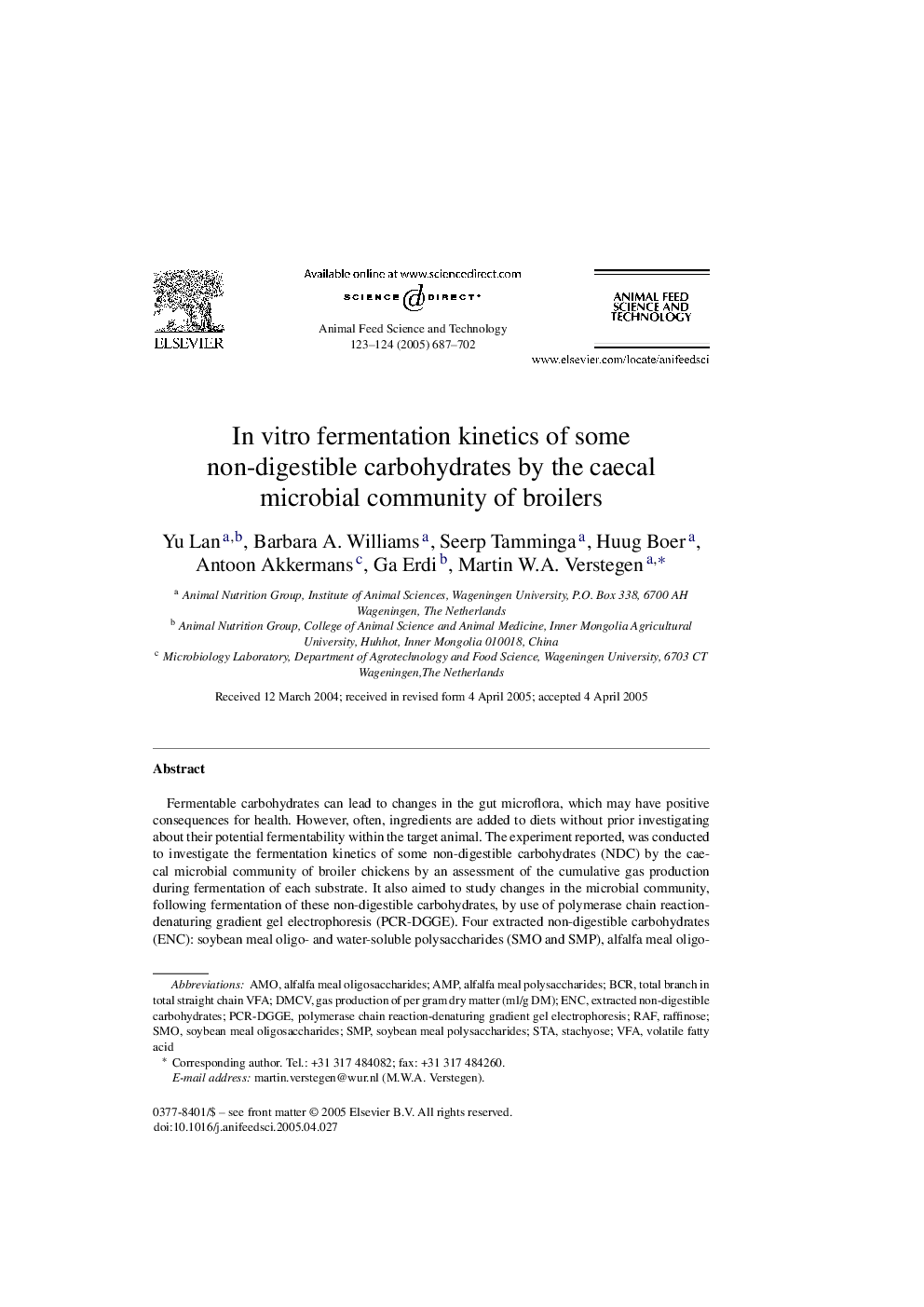| کد مقاله | کد نشریه | سال انتشار | مقاله انگلیسی | نسخه تمام متن |
|---|---|---|---|---|
| 9916586 | 1552506 | 2005 | 16 صفحه PDF | دانلود رایگان |
عنوان انگلیسی مقاله ISI
In vitro fermentation kinetics of some non-digestible carbohydrates by the caecal microbial community of broilers
دانلود مقاله + سفارش ترجمه
دانلود مقاله ISI انگلیسی
رایگان برای ایرانیان
کلمات کلیدی
VFASTAAMPBCRPCR-DGGEStachyoseRAFSMOENc - ENCvolatile fatty acid - اسید چرب فرارpolymerase chain reaction-denaturing gradient gel electrophoresis - الکتروفورز ژل شتاب دهنده واکنش زنجیره پلیمرازSMP - دانشکده دبیرستانRaffinose - رافینوزAMO - عشقFermentability - قابلیت تخمیرBroiler chickens - مرغ جوجههای گوشتی
موضوعات مرتبط
علوم زیستی و بیوفناوری
علوم کشاورزی و بیولوژیک
علوم دامی و جانورشناسی
پیش نمایش صفحه اول مقاله

چکیده انگلیسی
Fermentable carbohydrates can lead to changes in the gut microflora, which may have positive consequences for health. However, often, ingredients are added to diets without prior investigating about their potential fermentability within the target animal. The experiment reported, was conducted to investigate the fermentation kinetics of some non-digestible carbohydrates (NDC) by the caecal microbial community of broiler chickens by an assessment of the cumulative gas production during fermentation of each substrate. It also aimed to study changes in the microbial community, following fermentation of these non-digestible carbohydrates, by use of polymerase chain reaction-denaturing gradient gel electrophoresis (PCR-DGGE). Four extracted non-digestible carbohydrates (ENC): soybean meal oligo- and water-soluble polysaccharides (SMO and SMP), alfalfa meal oligo- and water-soluble polysaccharides (AMO and AMP) were studied. Two pure sugars, raffinose (RAF) and stachyose (STA) were also included. To assess the fermentability of the substrates, cumulative gas pressure was monitored continuously, for 72Â h, and at the end of fermentation, pH, volatile fatty acid (VFA), and ammonia (NH3) concentrations were measured in the fermentation solution. The PCR-DGGE technique was applied to compare microbial DNA fingerprints between substrates at the end of the fermentation. The inoculum for the in vitro gas production was obtained from a mixture of caecal contents of forty 81-day-old broiler birds. Soy oligosaccharides led to significantly more butyric acid production (P<0.05) after fermentation compared with other ENC. The production of butyric acid was 155.2Â mg/g DM, 100.3Â mg/g DM, 84.5Â mg/g DM and 71.8Â mg/g DM for SMO, SMP, AMP and AMO, respectively. Soy oligosaccharides had the lowest pH (5.5) and ammonia-nitrogen concentration (199.3Â mg/l) after fermentation. This was significantly different from other ENC and the pure sugars. DGGE analysis revealed that, the fingerprint of caecal bacterial communities showed some variation (C, value >60-80%) between some of the substrates. It was concluded that SMO, SMP, AMO and AMP, as well as RAF and STA were significantly different, both in terms of their fermentation kinetics and end-products using caecal contents from adult broilers. The extent to which these non-digestible, but fermentable, carbohydrates could change the microbial community of the broiler caecum, either in terms of the species detected, or its activity, needs to be investigated further, and then related to its effect on gut health in the animal itself.
ناشر
Database: Elsevier - ScienceDirect (ساینس دایرکت)
Journal: Animal Feed Science and Technology - Volumes 123â124, Part 2, 7 December 2005, Pages 687-702
Journal: Animal Feed Science and Technology - Volumes 123â124, Part 2, 7 December 2005, Pages 687-702
نویسندگان
Yu Lan, Barbara A. Williams, Seerp Tamminga, Huug Boer, Antoon Akkermans, Ga Erdi, Martin W.A. Verstegen,